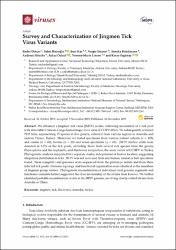| dc.contributor.author | Dinçer, Ender | |
| dc.contributor.author | Hacioglu, Sabri | |
| dc.contributor.author | Kar, Sırrı | |
| dc.contributor.author | Emanet, Nergis | |
| dc.contributor.author | Brinkmann, Annika | |
| dc.contributor.author | Nitsche, Andreas | |
| dc.contributor.author | Ergünay, Koray | |
| dc.date.accessioned | 2022-05-11T14:28:40Z | |
| dc.date.available | 2022-05-11T14:28:40Z | |
| dc.date.issued | 2019 | |
| dc.identifier.issn | 1999-4915 | |
| dc.identifier.uri | https://doi.org/10.3390/v11111071 | |
| dc.identifier.uri | https://hdl.handle.net/20.500.11776/6907 | |
| dc.description.abstract | We obtained a Jingmen tick virus (JMTV) isolate, following inoculation of a tick pool with detectable Crimean-Congo hemorrhagic fever virus (CCHFV) RNA. We subsequently screened 7223 ticks, representing 15 species in five genera, collected from various regions in Anatolia and eastern Thrace, Turkey. Moreover, we tested specimens from various patient cohorts (n = 103), and canine (n = 60), bovine (n = 20) and avian specimens (n = 65). JMTV nucleic acids were detected in 3.9% of the tick pools, including those from several tick species from the genera Rhipicephalus and Haemaphysalis, and Hyalomma marginatum, the main vector of CCHFV in Turkey. Phylogenetic analysis supported two separate clades, independent of host or location, suggesting ubiquitous distribution in ticks. JMTV was not recovered from any human, animal or bird specimens tested. Near-complete viral genomes were sequenced from the prototype isolate and from three infected tick pools. Genome topology and functional organization were identical to the members of Jingmen group viruses. Phylogenetic reconstruction of individual viral genome segments and functional elements further supported the close relationship of the strains from Kosovo. We further identified probable recombination events in the JMTV genome, involving closely-related strains from Anatolia or China. | en_US |
| dc.description.sponsorship | Armed Forces Health Surveillance Board, Global Emerging Infections Surveillance and Response System (AFHSB-GEIS), United States of America under US Army [FY18, P0034_18_WR, W911QY-16-C-0160] | en_US |
| dc.description.sponsorship | The study was supported in part by the Armed Forces Health Surveillance Board, Global Emerging Infections Surveillance and Response System (AFHSB-GEIS), United States of America (FY18 award P0034_18_WR (PI: Yvonne-Marie Linton) under US Army subcontract W911QY-16-C-0160). | en_US |
| dc.language.iso | eng | en_US |
| dc.publisher | Mdpi | en_US |
| dc.identifier.doi | 10.3390/v11111071 | |
| dc.rights | info:eu-repo/semantics/openAccess | en_US |
| dc.subject | jingmen | en_US |
| dc.subject | tick | en_US |
| dc.subject | flavivirus | en_US |
| dc.subject | Anatolia | en_US |
| dc.subject | turkey | en_US |
| dc.subject | Ns5 Protein | en_US |
| dc.subject | Identification | en_US |
| dc.subject | Flaviviruses | en_US |
| dc.subject | Epidemiology | en_US |
| dc.subject | Diversity | en_US |
| dc.subject | Emergence | en_US |
| dc.subject | Alignment | en_US |
| dc.subject | Domain | en_US |
| dc.subject | Acari | en_US |
| dc.title | Survey and Characterization of Jingmen Tick Virus Variants | en_US |
| dc.type | article | en_US |
| dc.relation.ispartof | Viruses-Basel | en_US |
| dc.department | Fakülteler, Fen Edebiyat Fakültesi, Biyoloji Bölümü | en_US |
| dc.authorid | 0000-0001-5422-1982 | |
| dc.authorid | 0000-0001-5008-9443 | |
| dc.authorid | 0000-0001-8185-3176 | |
| dc.authorid | 0000-0002-5493-0807 | |
| dc.identifier.volume | 11 | en_US |
| dc.identifier.issue | 11 | en_US |
| dc.institutionauthor | Kar, Sırrı | |
| dc.relation.publicationcategory | Makale - Uluslararası Hakemli Dergi - Kurum Öğretim Elemanı | en_US |
| dc.authorscopusid | 26326680200 | |
| dc.authorscopusid | 52263886700 | |
| dc.authorscopusid | 15769247000 | |
| dc.authorscopusid | 57209228994 | |
| dc.authorscopusid | 55258915300 | |
| dc.authorscopusid | 7004626809 | |
| dc.authorscopusid | 7004873534 | |
| dc.authorwosid | Linton, Yvonne-Marie/AAW-3992-2021 | |
| dc.authorwosid | hacioglu, sabri/ABG-9827-2021 | |
| dc.authorwosid | Ozkul, Aykut/A-1973-2016 | |
| dc.authorwosid | Ergunay, Koray/I-8368-2013 | |
| dc.identifier.wos | WOS:000502292300099 | en_US |
| dc.identifier.scopus | 2-s2.0-85075304817 | en_US |
| dc.identifier.pmid | 31744216 | en_US |



















